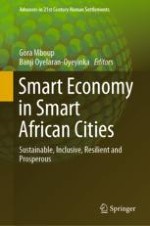
2019 | OriginalPaper | Chapter
1. Relevance of Smart Economy in Smart Cities in Africa
Authors : Gora Mboup, Banji Oyelaran-Oyeyinka
Published in: Smart Economy in Smart African Cities
Publisher: Springer Singapore
Activate our intelligent search to find suitable subject content or patents.
Select sections of text to find matching patents with Artificial Intelligence. powered by
Select sections of text to find additional relevant content using AI-assisted search. powered by